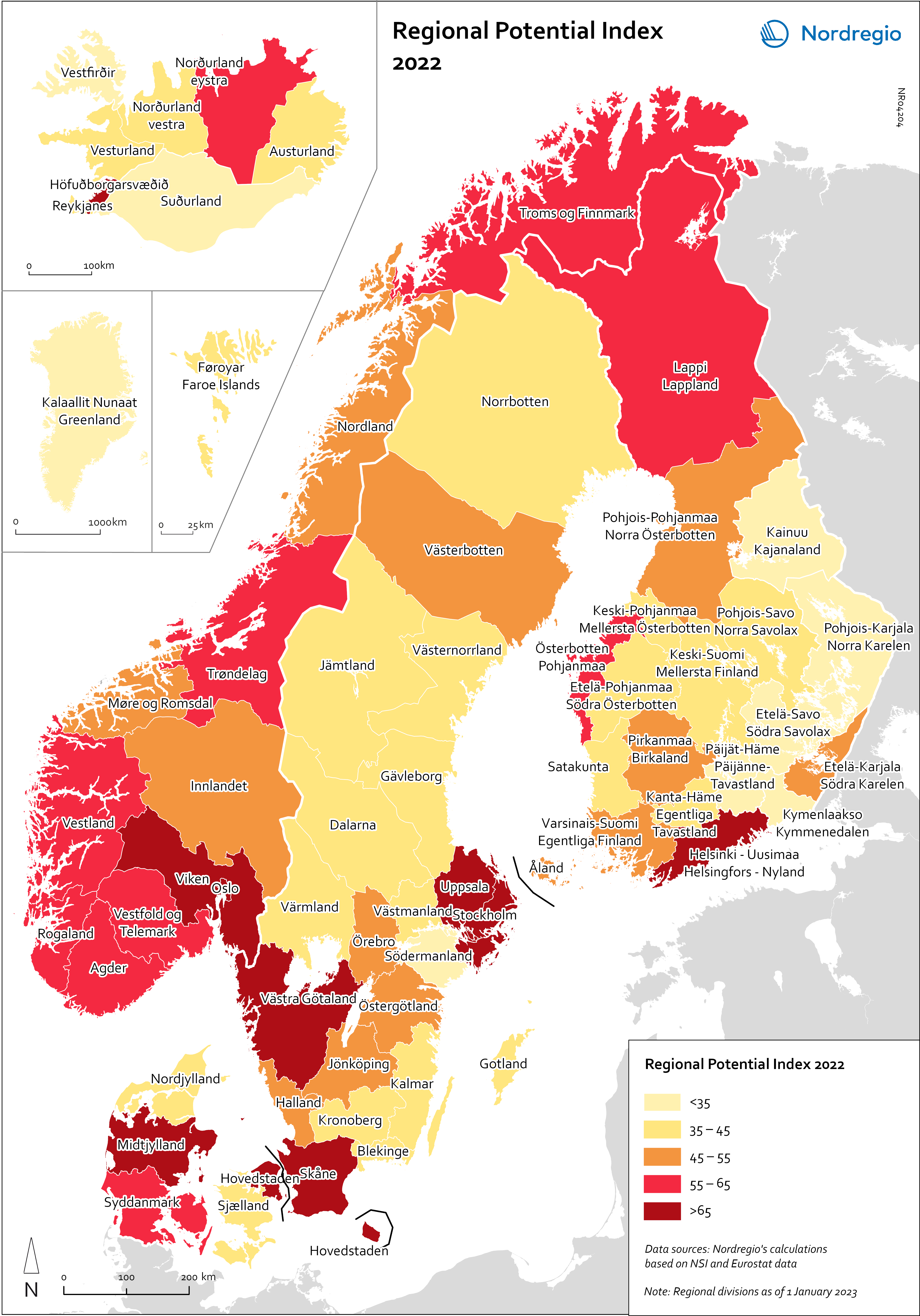This map shows the result of Nordregio’s Regional Potential Index in 2024 (data from 2022).
Nordregio’s Regional Potential Index (RPI) enables cross-regional comparison of development potential and illustrates the regional balance between the Nordic countries and has been part of the State of the Nordic Region report since 2018. The purpose of this multidimensional index is to summarise the current and past performance of the Nordic regions across major policy domains. The index helps to identify regions that have high potential and those in need of further support to boost their potential and meet existing challenges. It provides policy-makers with a comparative learning tool that informs the design of effective regional development strategies at Nordic level.
Nordregio’s RPI is a multi-item measurement scale that incorporates information about the demographics, labour market and economic output of the Nordic countries’ 66 administrative regions. It consists of eight indicators classified into four main groups and eight subgroups. These components and indicators were originally selected on the basis of their relevance for regional development.
The 2024 RPI is based on a new refined method that maintains a similar set of indicators but applies a more robust statistical process to the construction of the RPI. In brief, the new methodology consists of a pre-processing stage, in which the input data is prepared for analysis, and a processing stage, in which the indicators are weighted and aggregated. More information about the method can be found in the State of the Nordic Region 2024 report.
The RPI was calculated retroactively for the 2015–2023 period. However, the focus in this section is on 2022 – the most recent year in our time series with full data coverage. The map shows the redesigned RPI for that period. In line with the principles of accumulation and agglomeration that drive the global economy, the RPI highlights the role of the Nordic countries’ largest cities and city regions. The top performing region in 2022 was Oslo, the Capital Region of Norway, followed by Stockholm County and the capital regions of Denmark and Iceland.
On the other end of the RPI spectrum, we find regions such as Greenland, the Eastern Region in Iceland, and South Savo and Päijät-Häme in Finland. All of these regions are characterised by sparse populations, rural economies, and in some cases, remoteness.
Greenland has the lowest overall RPI, with low rankings for most indicators but not all. For instance, Greenland boasts one of the lowest demographic dependency ratios in the Nordic Region, and youth unemployment does not appear to be a significant issue. However, the region consistently underperforms in indicators such as gender balance, educational attainment and degree of urbanisation. This description is also largely applicable to the Eastern Region of Iceland.
Like several other areas across the Nordics, regions in Eastern Finland have one of the fastest-ageing populations, and increasing life expectancy is leading to growth in the elderly population. Concurrently, even though Eastern Finland’s economy is developing, the labour market presents discouraging figures, with comparatively lower employment rates and higher youth unemployment rates than the national and Nordic averages. This could explain why, unlike other rural Nordic regions, several landlocked Finnish regions near the Russian border are struggling to counter some of the challenges posed by an ageing population, such as a shrinking labour supply and escalating public-sector costs. The same situation applies to Södermanland County in Sweden, even though this region also struggles with one of the Nordics’ highest youth unemployment rates.

